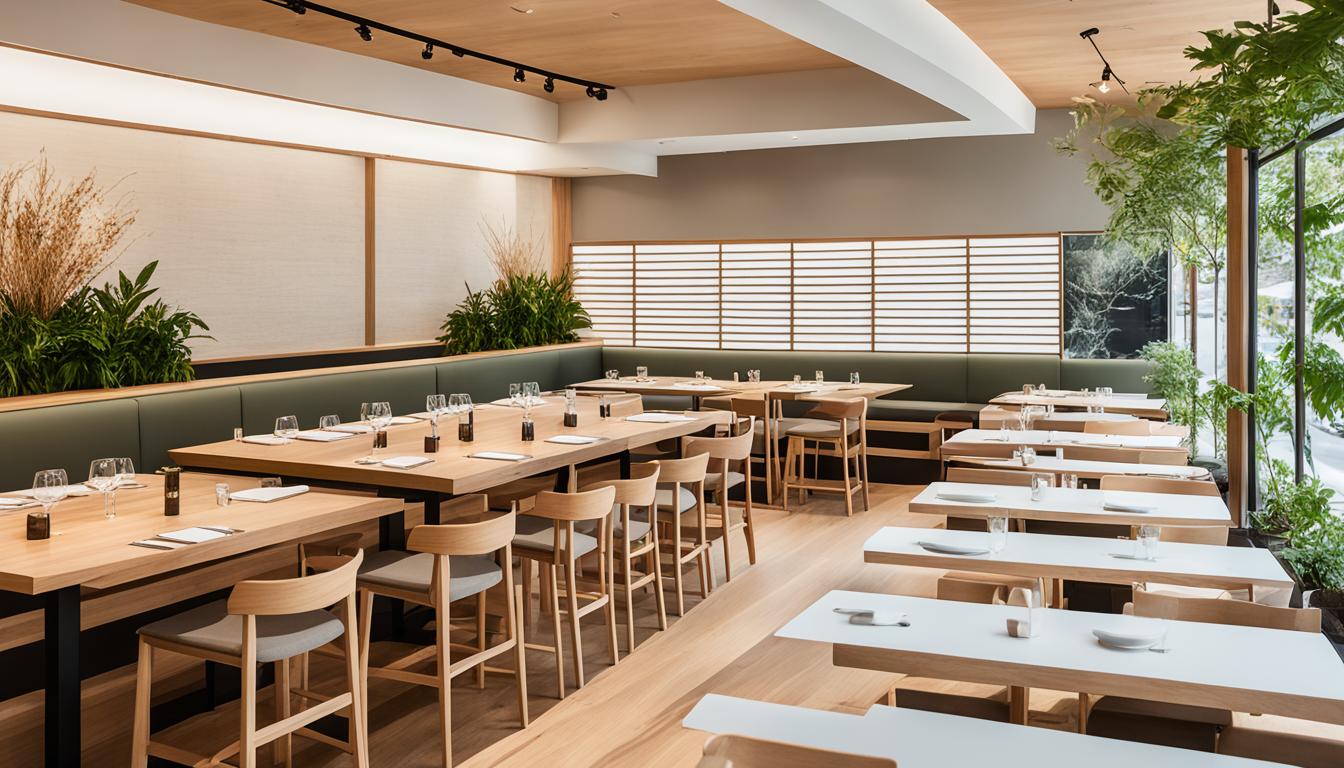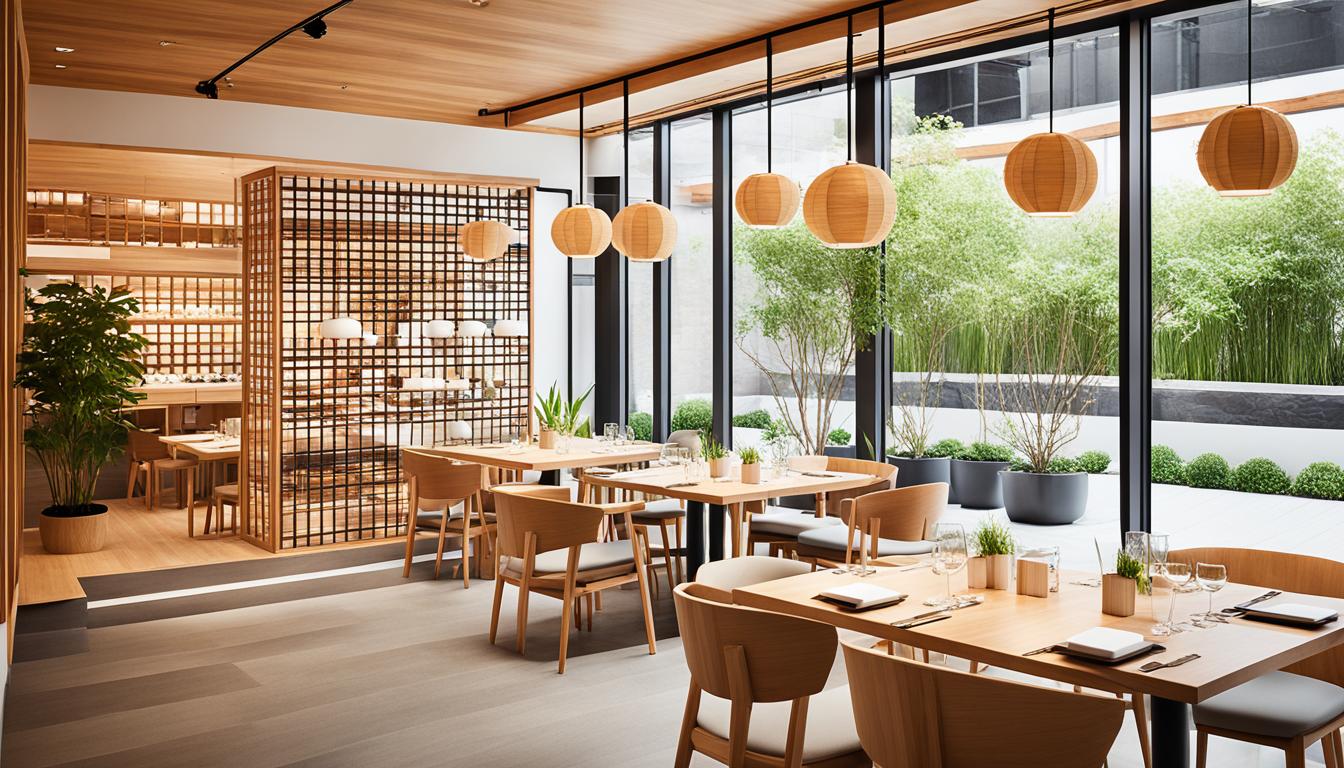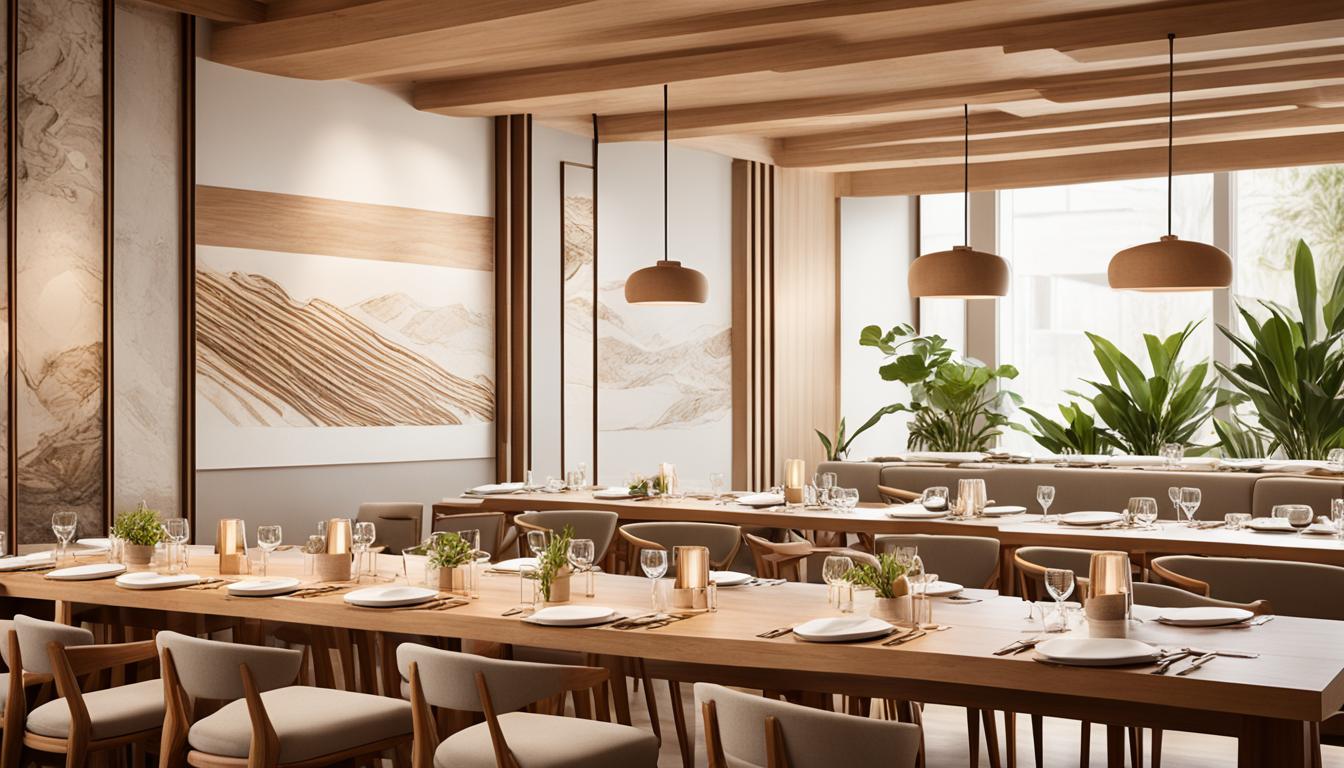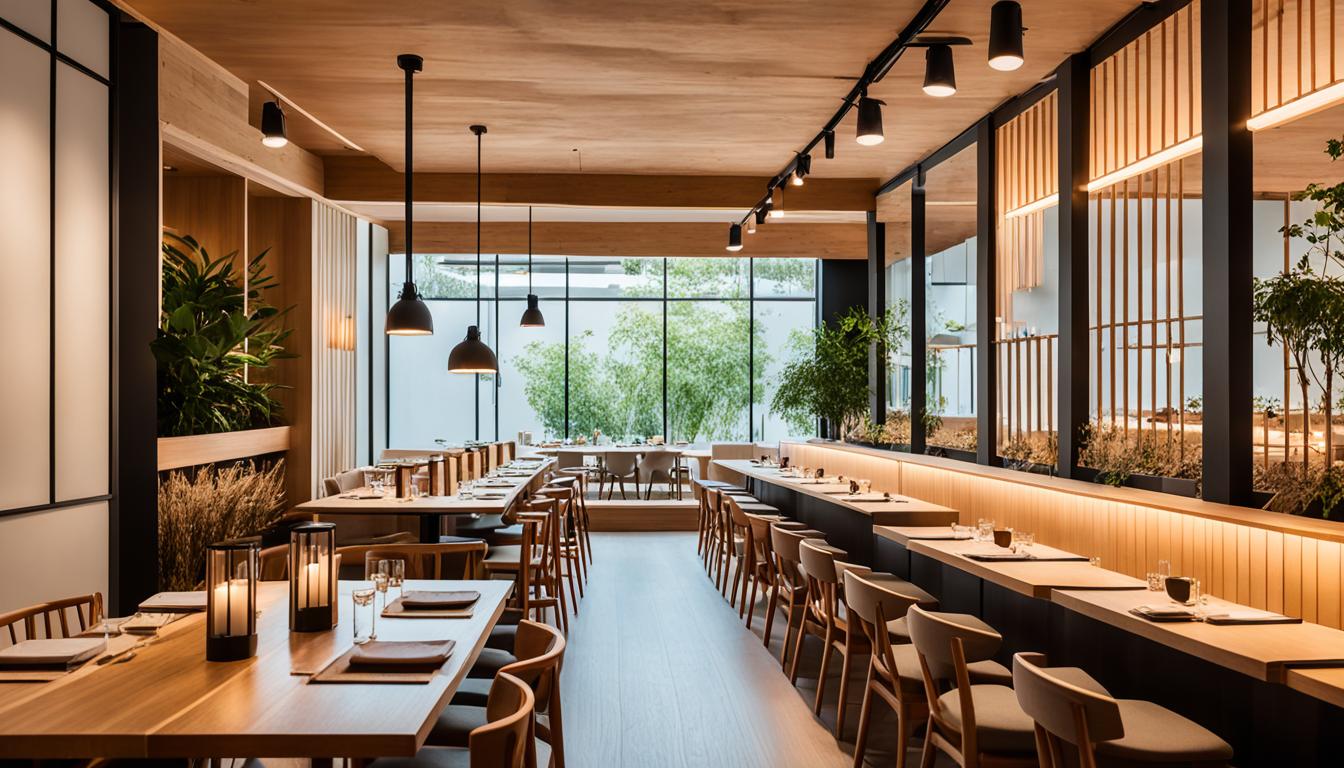🤍 Unmatched Quality, Authentic Craftsmanship
🤍 Unmatched Quality, Authentic Craftsmanship
🤍 Unmatched Quality, Authentic Craftsmanship
Welcome to our blog where we explore the fascinating world of Japandi restaurant design. If you’re seeking inspiration for creating chic and serene interiors for your restaurant, you’ve come to the right place. Japandi design seamlessly combines the elegance of Japanese minimalism with the cozy charm of Scandinavian style, resulting in a dining experience that is both visually appealing and serene. With natural materials, clean lines, and a neutral color palette, Japandi design offers a harmonious ambiance that is sure to captivate your customers. When it comes to creating a unique and inviting dining experience, Japandi style is a trend that restaurant owners should embrace. This design approach combines the best of Japanese minimalism and Scandinavian coziness to deliver a harmonious and serene ambiance. By incorporating the essence of Japandi aesthetics, restaurant owners can achieve a minimalist and cozy dining experience that leaves a lasting impression on their customers. Japandi aesthetics revolve around the principles of simplicity, functionality, and natural elements. This design style emphasizes clean lines, uncluttered spaces, and a neutral color palette, which create a sense of serenity and balance. By incorporating elements from both Japanese traditionalism and Scandinavian design, Japandi style showcases a fusion of cultures that results in a truly unique and captivating ambiance. Creating a minimalist and cozy dining experience is at the core of Japandi style. By focusing on Scandinavian functionality, restaurant owners can optimize their space to promote a seamless and enjoyable dining experience. The use of multifunctional furniture, hidden storage solutions, and efficient layouts can help maximize both comfort and functionality, enabling customers to relax and savor their meals in a cozy atmosphere. The fusion of Scandinavian functionality and Japanese traditionalism is a defining aspect of Japandi style. By incorporating Scandinavian design elements like clean lines, natural materials, and ample natural light, alongside Japanese traditional influences such as handmade ceramics and traditional motifs, restaurant owners can achieve a perfect balance between comfort and cultural authenticity. This fusion design allows for a serene and inviting dining space that seamlessly blends the best of both worlds. In this section, we explore various Japandi restaurant design ideas that can inspire restaurant owners to create their own unique spaces. From incorporating natural elements to utilizing a neutral color palette, these design ideas aim to enhance the overall dining experience and create a serene and inviting atmosphere for customers. To begin, let's take a look at the benefits of incorporating natural elements into Japandi restaurant design. By using materials such as textured wood and handmade ceramics, you can create a tactile dining atmosphere that evokes a sense of warmth and authenticity. These natural elements not only add visual interest but also contribute to a more grounded and peaceful dining experience. When it comes to color choices, a neutral palette is key in achieving the desired harmony and calmness. Utilizing shades of beige, grey, and pale pastels can create a soothing ambiance that allows customers to focus on their dining experience. These neutral colors also provide a timeless and elegant backdrop that complements the Japandi aesthetic. Furthermore, clean lines and organic forms play a crucial role in Japandi design. By combining Japanese simplicity with Scandinavian elegance, you can create a visually pleasing and harmonious dining space. Choosing furniture that balances functionality and aesthetics is essential in achieving the desired Japandi aesthetic. Lastly, spatial layout and flow are integral to creating an immersive dining experience. Consider the arrangement of tables, seating areas, and circulation paths to optimize space and facilitate a smooth flow for customers. By thoughtfully planning the spatial layout, you can enhance the overall dining experience and create a welcoming environment. Creating authentic Japandi interiors requires the artful integration of natural elements. By incorporating these elements, we can achieve a harmonious and serene fusion dining space that reflects the essence of Japandi design. In this section, we will explore three key components of natural elements in Japandi decor: textured wood and handmade ceramics, bespoke lighting, and the inclusion of indoor plants. One of the defining characteristics of Japandi design is the use of textured wood and handmade ceramics. These natural materials infuse the space with warmth and create a tactile dining atmosphere. The textured wood adds depth and richness to the interior, while the handmade ceramics bring an element of craftsmanship and authenticity. Together, they create a sense of connection to nature and a unique dining experience. Bespoke lighting plays a crucial role in enhancing the ambiance of Japandi interiors. Natural light is favored in this design style, as it creates a warm and inviting atmosphere. Large windows or skylights can be incorporated to maximize the use of natural light during the day. In the evening, soft, warm light fixtures such as pendant lights or floor lamps can be strategically placed to create a cozy and intimate dining setting. By carefully considering the lighting elements, we can transform the dining space into a serene and inviting environment. Indoor plants are an essential element in Japandi decor, bringing life and vitality to the space. The use of indoor plants adds a touch of greenery, connecting the interior with nature. From small potted plants on shelves to larger statement plants in corners, indoor plants create a sense of calm and tranquility. Additionally, they contribute to improved air quality, promoting a healthier environment for both customers and staff. Incorporating indoor plants in Japandi decor is a simple yet highly effective way to create an authentic and soothing dining experience. In Japandi restaurant design, creating a serene and calming atmosphere is essential to enhance the dining experience. One effective way to achieve this is by incorporating a neutral color palette. Neutral colors such as beige, grey, and pale pastels are known for their ability to evoke a sense of tranquility and timelessness. When used in restaurant spaces, a neutral color scheme creates a harmonious and calming ambiance that appeals to a wide range of customers. The simplicity and elegance of neutral tones allow other design elements, such as natural materials and clean lines, to take center stage. The use of a neutral palette in Japandi restaurant design not only promotes a sense of harmony and calmness but also provides a versatile backdrop for different interior styles. Whether it's a modern, minimalist interior design restaurant or a cozy, rustic eatery, a neutral color scheme adapts seamlessly and enhances the overall aesthetic appeal of the space. By choosing neutral tones for walls, furniture, and decor, restaurant owners can create a soothing atmosphere that allows customers to focus on their dining experience. Neutral colors also have the advantage of being visually pleasing and timeless, ensuring that the restaurant design remains relevant and appealing for years to come. When it comes to Japandi restaurant design, the combination of clean lines and organic forms is essential in creating a visually stunning and harmonious dining space. This design approach seamlessly integrates the simplicity of modern Japanese aesthetics with the elegance of Scandinavian design, resulting in a unique and inviting atmosphere. In Japandi restaurant design, Japanese simplicity meets cozy Scandinavian vibe to create an aesthetic that is both minimalistic and refined. This style emphasizes the use of natural materials, such as wood and stone, to bring a sense of warmth and tranquility to the space. The clean lines of Japanese design are complemented by the organic forms found in Scandinavian interiors, resulting in a perfect balance between simplicity and sophistication. Furniture plays a crucial role in Japandi restaurant design, contributing not only to the overall aesthetic but also to the functionality of the space. In keeping with the clean lines and organic forms, furniture in Japandi interiors is often characterized by its minimalist design, with a focus on simplicity and functionality. Natural materials, such as light-toned wood, bamboo, or rattan, are commonly used to create a sense of warmth and authenticity. The furniture layout is carefully considered to optimize the flow of the space, ensuring a comfortable and inviting dining experience for patrons. In Japandi restaurant design, creating an immersive dining experience goes beyond just the aesthetics. It also involves careful consideration of the spatial layout and flow of the restaurant. A well-planned layout not only maximizes the use of space but also enhances the overall dining experience for customers. To achieve optimal spatial layout, restaurant owners should focus on creating a harmonious arrangement of furniture, fixtures, and decor. By strategically placing tables, chairs, and other elements, they can ensure a comfortable and visually appealing dining space. The flow of the restaurant plays a crucial role in providing a seamless and enjoyable dining experience. It should allow customers to move effortlessly from the entrance to their seats and through different dining areas. A well-designed flow eliminates any potential bottlenecks and ensures a smooth transition between various sections of the restaurant. When it comes to Japandi restaurant decor, artisanal details are key in creating a unique and authentic atmosphere. These details add a touch of craftsmanship and individuality to the space, elevating it from ordinary to extraordinary. One of the defining characteristics of Japandi design is the celebration of imperfections. This concept, known as Wabi-Sabi, embraces the beauty of natural flaws and irregularities. In Japandi restaurant decor, incorporating Wabi-Sabi aesthetics means appreciating the charm of handmade items, weathered textures, and patina. Scandinavian crafts and Japanese ceramics are essential elements in Japandi restaurant decor. These artisanal pieces add depth and character to the space, creating visual interest and a sense of authenticity. Scandinavian crafts, with their clean lines and functionality, perfectly complement the minimalistic aesthetic of Japandi design. On the other hand, Japanese ceramics bring organic shapes and intricate details, infusing the space with a touch of traditional Japanese craftsmanship. Incorporating sustainable materials and eco-friendly practices is a fundamental aspect of Japandi restaurant design. By choosing sustainable materials, restaurant owners can not only contribute to environmental conservation but also create a more conscious and responsible dining environment. Using sustainable materials such as bamboo, reclaimed wood, and recycled glass can significantly reduce the environmental impact of restaurant interiors. These materials are not only aesthetically pleasing but also durable, ensuring longevity in design. Eco-friendly practices go hand in hand with sustainable materials. Implementing energy-efficient lighting systems, installing low-flow faucets and toilets, and properly managing waste are just a few examples of eco-friendly practices that can be incorporated into Japandi restaurant design. Embracing eco-friendly practices benefits both the environment and the restaurant business itself. Not only do customers increasingly prefer dining establishments with sustainable practices, but implementing such practices can also lead to cost savings in the long run. Now that you have read the above article, maybe you still have a couple of questions on this topic, so we will answer these questions below. Japandi restaurant design combines the elements of Japanese minimalism and Scandinavian coziness to create a chic and serene dining experience. It focuses on the use of natural materials, clean lines, and a neutral color palette to create a harmonious and calming atmosphere in restaurants. There are various Japandi restaurant design ideas that can inspire restaurant owners to create their own unique spaces. From incorporating natural elements to utilizing a neutral color palette, these design ideas aim to enhance the overall dining experience and create a serene and inviting atmosphere for customers. Yes, Japandi design is considered a timeless trend in restaurant interiors. Its fusion of Japanese minimalism and Scandinavian elegance offers a contemporary and sophisticated aesthetic that appeals to a wide range of customers. By embracing Japandi design principles, restaurants can create a serene and harmonious dining environment that fosters mindfulness and balance. The combination of Japanese minimalism and Scandinavian coziness brings together the best of both worlds, inviting customers to experience a sense of calm and tranquility during their dining experience. Japandi design is not just a passing trend; it is here to stay. Its timeless appeal lies in its ability to create a timeless and elegant aesthetic that transcends cultural boundaries. The use of natural materials, clean lines, and a neutral color palette ensures that Japandi design will continue to be sought after in restaurant interiors for years to come. As restaurant owners, incorporating Japandi design into our spaces allows us to not only create visually stunning interiors but also provide our customers with a dining experience that nurtures their well-being. The mindfulness and balance fostered by Japandi design principles elevate the overall dining experience and create spaces where both customers and restaurant owners can find solace and serenity.

Key Takeaways:
Embracing Japandi Style in Restaurant Ambiance
The Essence of Japandi Aesthetics
Creating a Minimalist and Cozy Dining Experience
Fusion of Scandinavian Functionality and Japanese Traditionalism

Japandi Restaurant Design Ideas

Incorporating Natural Elements for Authentic Japandi Interiors
Textured Wood and Handmade Ceramics: A tactile dining atmosphere
Bespoke Lighting: The Importance of Natural and Warm Light
The Art of Indoor Plants in Japandi Decor
Natural Elements
Characteristics
Textured Wood
Depth and richness
Handmade Ceramics
Craftsmanship and authenticity
Bespoke Lighting
Natural and warm light
Indoor Plants
Greenery and vitality
A Neutral Palette for Harmony and Calm

Beige
Grey
Pale Pastels
Creates a warm and inviting atmosphere
Conveys a sense of sophistication and modernity
Evoke a soft and delicate ambiance
Works well with natural materials like wood
Allows other colors and textures to stand out
Brings a touch of playfulness and serenity
Combining Clean Lines with Organic Forms

Japanese Simplicity Meets Scandinavian Elegance
The Role of Furniture in Japandi Restaurant Design
Immersive Japandi Dining: Spatial Layout and Flow
Key Elements
Features
Entrance
Welcoming and uncluttered entrance with signage and display of natural materials
Reception Area
Comfortable seating for waiting customers and a clear view of the dining areas
Dining Zones
Distinct dining areas with varying levels of privacy and ambiance
Walkways
Efficient and well-planned walkways that facilitate easy movement and accessibility
Service Stations
Conveniently located service stations for staff to efficiently serve customers
Amenities
Well-designed restrooms and other amenities that blend seamlessly with the overall design
Artisanal Details in Japandi Restaurant Decor
Celebrating Imperfections: Wabi-Sabi in Restaurant Aesthetics
Scandinavian Crafts and Japanese Ceramics in Japandi Spaces
Sustainable Materials and Eco-Friendly Practices
Frequently Asked Questions
What is Japandi restaurant design?
What are some Japandi restaurant design ideas?
Is Japandi design a timeless trend in restaurant interiors?
Conclusion


